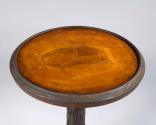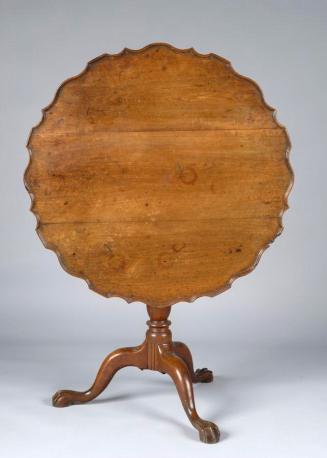Stand
Furniture MakerMade by
Peter Lux
(American, 1835 - 1904)
Date1858-1859
MediumOak veneer, oak bark and oak primary woods, mahogany and pine secondary woods, brass hardware
DimensionsPrimary Dimensions (height x diameter): 29 5/8 x 25 1/8in. (75.2 x 63.8cm)
Component (maximum width between two feet): 16 1/2in. (41.9cm)
ClassificationsFurniture
Credit LineDonated by the family of Merrit W. Treat
Object number1972.45.0
DescriptionOak stand in the rustic Victorian style, made with wood and bark from the Charter Oak. The top is round and has a surface constructed of irregular blocks of wood. The top is circled with raised molding that is covered with bark. The top is not stationary, but tilts up into a vertical position. The pedestal is cylindrical with a large acorn applied to the underside of the base; both the pedestal and acorn are covered with thick bark. The stand has four legs, also coated in bark, each with a series of projecting and recessed C-scrolls on the upper surface ending with feet that curl upward over a castor.
Condition: Some small pieces of bark have flaked off each of the four legs. Portions of the molding around the edge of the top have been replaced or repaired. At least one section of the molding that projects above the top is loose. The brass catch on the underside of the top is replaced.
Design and Construction Details: The top is constructed of multiple, irregular blocks of wood that are screwed from the underside to a wooden disc. The molding is applied to the edge of the top and held in place with L-shaped metal brackets that are screwed to the underside of the top and the molding. A pair of slender, trapezoidal cleats is screwed to the underside of the top. Between each cleat is a block which is attached to the cleats with round hinge pins; the top pivots on these pins. A brass catch holds the top in a horizontal position. The top of the pedestal is joined to the block with a rectangular through tenon that is wedged in the center. The bark is pounded up and glued to the the molding around the top, the pedestal and the four legs.
NotesHistorical Note: The Charter Oak, located on the Wyllys estate in Hartford, hid the state's royal charter when a representative of the English government attempted to seize it in 1687. The tree fell down during a storm in 1856. The patriotic story of the Charter Oak has since become a deeply rooted part of Connecticut's history.Condition: Some small pieces of bark have flaked off each of the four legs. Portions of the molding around the edge of the top have been replaced or repaired. At least one section of the molding that projects above the top is loose. The brass catch on the underside of the top is replaced.
Design and Construction Details: The top is constructed of multiple, irregular blocks of wood that are screwed from the underside to a wooden disc. The molding is applied to the edge of the top and held in place with L-shaped metal brackets that are screwed to the underside of the top and the molding. A pair of slender, trapezoidal cleats is screwed to the underside of the top. Between each cleat is a block which is attached to the cleats with round hinge pins; the top pivots on these pins. A brass catch holds the top in a horizontal position. The top of the pedestal is joined to the block with a rectangular through tenon that is wedged in the center. The bark is pounded up and glued to the the molding around the top, the pedestal and the four legs.
Status
Not on view
















